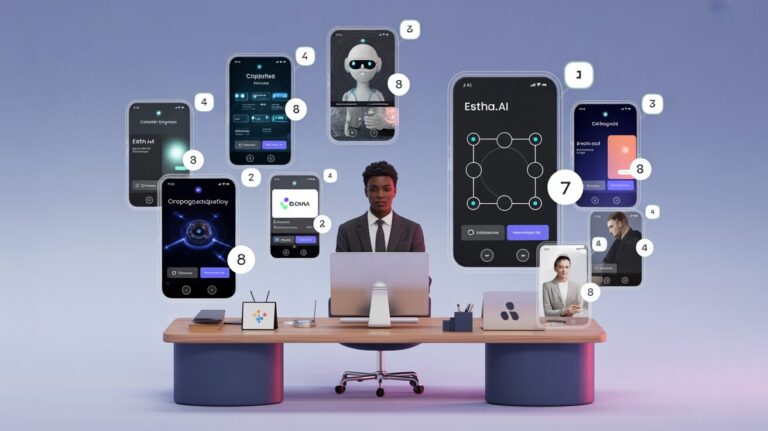Table Of Contents
- Introduction
- Understanding GPT Technology: The Foundation of Modern AI Apps
- What is a GPT-Powered App Builder?
- Benefits of Using GPT-Powered App Builders
- Key Features to Look for in a GPT-Powered App Builder
- Getting Started: Building Your First AI App
- Real-World Applications of GPT-Powered Apps
- Challenges and Limitations to Consider
- The Future of GPT-Powered App Development
- Conclusion
What is GPT-Powered App Builder? A Beginner’s Guide to Creating AI Applications Without Coding
Imagine being able to create a sophisticated AI application that can answer complex questions, generate content, or automate tasks—all without writing a single line of code. Just a few years ago, this would have seemed impossible for anyone without extensive programming knowledge and AI expertise. Today, thanks to GPT-powered app builders, this capability is at the fingertips of entrepreneurs, educators, content creators, and professionals in virtually every industry.
The rise of Generative Pre-trained Transformer (GPT) technology has revolutionized how we interact with artificial intelligence. Now, no-code platforms are democratizing this technology, allowing anyone to harness the power of advanced AI without technical barriers. Whether you’re looking to create an interactive chatbot for your business, develop an AI teaching assistant, or build a personalized recommendation engine, GPT-powered app builders are making it possible for everyone to participate in the AI revolution.
In this comprehensive guide, we’ll explore what GPT-powered app builders are, how they work, and how you can use them to create powerful AI applications—even if you’ve never written a line of code. From understanding the underlying technology to practical steps for building your first AI app, this article will equip you with everything you need to know to get started on your AI development journey.
GPT-Powered App Builders
Create AI Applications Without Coding
What Are GPT-Powered App Builders?
Platforms that allow anyone to create sophisticated AI applications without coding knowledge by providing intuitive visual interfaces that abstract away the technical complexities of working with large language models.
Accessibility
Enables non-technical users to create AI applications without coding or AI expertise
Speed
Build in minutes what would take months with traditional development approaches
Cost Effectiveness
Eliminates need for expensive development teams and technical infrastructure
How to Build Your First AI App
Define your application’s purpose and goals
Gather your knowledge base resources
Select platform and appropriate template
Design application flow and interactions
Customize, test, and refine your application
Deploy and share your finished AI application
Key Features to Look For
Intuitive Interface
Visual drag-drop-link editors that require no technical knowledge
Knowledge Base Integration
Easy import of specialized documents and data sources
Customization Options
Control over AI responses, tone, and behavior boundaries
Analytics & Improvement Tools
Insights on usage patterns to refine your application
Real-World Applications
Business
Customer service chatbots, sales assistants, knowledge bases
Education
AI tutors, interactive study guides, assessment tools
Healthcare
Patient information systems, symptom checkers, scheduling
Start Building Your AI Application Today
Create custom AI solutions in minutes with no coding required
The democratization of AI development through GPT-powered app builders enables diverse perspectives to shape how AI technology is applied across industries.
Understanding GPT Technology: The Foundation of Modern AI Apps
Before diving into app builders, it’s important to understand what powers them. GPT (Generative Pre-trained Transformer) is a type of large language model (LLM) that can understand, generate, and manipulate human language with remarkable sophistication. These models are trained on vast amounts of text data from the internet, books, articles, and other sources, allowing them to develop an understanding of language patterns, facts, concepts, and even some reasoning capabilities.
GPT models work by predicting the next word in a sequence based on the context of previous words. This seemingly simple capability, when scaled up with billions of parameters, enables them to perform a wide range of language tasks—from answering questions and summarizing text to writing code and generating creative content. The latest iterations, including GPT-4, demonstrate an unprecedented ability to understand nuanced prompts and produce human-like responses across various domains of knowledge.
What makes GPT technology particularly revolutionary is its versatility. Unlike traditional software that’s programmed for specific tasks, GPT models can be applied to virtually any task involving language or symbolic reasoning, making them incredibly flexible building blocks for applications. This flexibility is what enables non-technical users to create sophisticated AI applications without needing to understand the complex machine learning processes happening behind the scenes.
What is a GPT-Powered App Builder?
A GPT-powered app builder is a platform that abstracts away the complexity of working directly with large language models, providing an intuitive interface that allows users to create functional AI applications without coding. These platforms act as intermediaries between the raw capabilities of GPT models and the specific applications users want to build.
At its core, a GPT-powered app builder provides:
- A visual interface for designing the application’s functionality
- Pre-configured components that leverage GPT capabilities
- Tools for customizing the AI’s behavior without programming
- Methods to train or fine-tune the AI with specialized knowledge
- Options for deployment and sharing the finished application
For example, Estha offers an intuitive drag-drop-link interface that allows users to create custom AI applications in just 5-10 minutes. This approach removes the traditional barriers to AI development, enabling anyone with domain expertise to transform their knowledge into a functional AI application regardless of their technical background.
The key innovation of these platforms is that they translate user intentions into the technical instructions needed to make GPT models perform specific tasks. Rather than requiring users to learn prompt engineering or programming, they provide visual elements and natural language interfaces that anyone can understand and use.
Benefits of Using GPT-Powered App Builders
Accessibility for Non-Technical Users
Perhaps the most significant advantage of GPT-powered app builders is their accessibility. These platforms remove the technical barriers that have traditionally kept AI development in the hands of specialists. Now, subject matter experts in fields like healthcare, education, marketing, or customer service can create AI tools that reflect their specialized knowledge without needing to collaborate with developers or data scientists.
Speed of Development
Building AI applications from scratch can take months or even years of development time. GPT-powered app builders compress this timeline dramatically. What once required a team of engineers can now be accomplished by a single person in hours or days. This rapid development cycle allows for quick iteration and experimentation, enabling users to refine their applications based on real-world feedback without significant resource investment.
Cost Effectiveness
Traditional AI development comes with substantial costs: hiring specialized talent, investing in infrastructure, and allocating time for development and testing. GPT-powered app builders significantly reduce these expenses by providing ready-to-use infrastructure and eliminating the need for technical expertise. This democratization puts powerful AI capability within reach of small businesses, independent professionals, and educational institutions with limited budgets.
Customization and Personalization
Despite their no-code nature, these platforms offer surprising flexibility for customization. Users can tailor their AI applications to incorporate specific knowledge bases, brand voices, interaction styles, and functionalities. This ensures that the resulting applications genuinely reflect the creator’s expertise and intentions rather than generic AI capabilities.
Key Features to Look for in a GPT-Powered App Builder
When evaluating GPT-powered app builders, several key features can significantly impact your development experience and the capabilities of your finished application:
Intuitive Interface and Design Tools
The interface should be accessible to non-technical users while still providing enough depth for complex applications. Look for visual editors with drag-and-drop functionality, clear component labeling, and intuitive workflows. The ability to design both the application’s behavior and user interface without coding is essential for true accessibility.
Knowledge Base Integration
The platform should allow you to easily incorporate your own knowledge, documents, and data to specialize the AI for your specific domain. This might include the ability to upload documents, connect to databases, or manually input information that the AI can reference when interacting with users.
Customization Options
Look for platforms that allow you to control how the AI responds, the tone it adopts, and the limits of its capabilities. The ability to set parameters for the AI’s behavior ensures your application reflects your values and meets your specific requirements. This includes controlling the types of responses the AI can generate and defining how it handles various user interactions.
Integration Capabilities
The most useful AI applications often don’t stand alone but integrate with existing systems and workflows. Strong platforms offer options to embed your AI applications into websites, connect them with other software, or make them accessible through various channels like messaging platforms or custom interfaces.
Analytics and Improvement Tools
Understanding how users interact with your AI application provides crucial insights for improvement. Platforms should offer analytics on usage patterns, common questions, success rates, and other metrics that help you refine your application over time. Some platforms also provide automated suggestions for improvement based on observed interactions.
Getting Started: Building Your First AI App
Starting your journey with GPT-powered app builders is simpler than you might expect. Here’s a general process that applies to most platforms, including Estha:
Step 1: Define Your Application’s Purpose
Before touching any tools, clearly define what you want your AI application to do. Are you creating a customer service chatbot? A personal tutor for a specific subject? A creative writing assistant? Having a clear vision helps guide your development process and ensures you include all necessary components.
Step 2: Gather Your Knowledge Base
Collect the information your AI will need to access. This might include product documentation, educational materials, frequently asked questions, process guidelines, or any specialized knowledge relevant to your application’s purpose. Organizing this information before you begin building will streamline the development process.
Step 3: Choose Your Platform and Templates
Select a GPT-powered app builder that aligns with your needs. Many platforms, including Estha, offer templates for common application types like chatbots, virtual assistants, or knowledge bases. Starting with a relevant template can significantly accelerate your development process by providing pre-configured components tailored to specific use cases.
Step 4: Design Your Application Flow
Using the platform’s visual editor, map out how users will interact with your application. Define conversation flows, decision points, and information retrieval processes. Consider different user scenarios and ensure your application can handle various types of inquiries or requests related to its purpose.
Step 5: Customize and Test
Refine your application’s responses, appearance, and behavior to match your vision. Most platforms allow extensive customization without coding, including defining the AI’s tone, setting boundaries for its responses, and designing the user interface. Thoroughly test your application with diverse inputs to ensure it responds appropriately across various scenarios.
Step 6: Deploy and Share
Once you’re satisfied with your application’s functionality, deploy it through your chosen platform. Depending on the platform and your needs, deployment options might include embedding the application on your website, sharing it through a dedicated link, or integrating it with other tools and services.
Real-World Applications of GPT-Powered Apps
The versatility of GPT-powered app builders enables a wide range of practical applications across industries:
Business Applications
Businesses are using GPT-powered apps to create customer service chatbots that can handle inquiries 24/7, virtual sales assistants that guide customers through product selections, and internal knowledge bases that make company information instantly accessible to employees. These applications improve efficiency, reduce costs, and enhance customer experiences without requiring significant technical investment.
Educational Tools
Educators are developing AI tutors that provide personalized learning experiences, interactive study guides that adapt to student needs, and assessment tools that offer immediate feedback. These applications extend educational resources beyond traditional classroom hours and provide additional support tailored to individual learning styles.
Healthcare Support
Healthcare professionals are creating patient information systems that answer common questions, appointment scheduling assistants that streamline administrative tasks, and symptom checkers that provide initial guidance while directing serious concerns to human providers. These tools improve patient access to information while freeing healthcare workers to focus on complex cases requiring human expertise.
Content Creation
Writers, marketers, and creators are building specialized assistants that help generate content ideas, provide research support, or offer feedback on drafts. These tools serve as collaborative partners in the creative process, enhancing productivity without replacing human creativity and judgment.
Challenges and Limitations to Consider
Despite their power and accessibility, GPT-powered app builders do come with certain limitations and challenges:
Knowledge Limitations
GPT models have knowledge cutoffs—points beyond which they don’t have information about world events or developments. This means applications built on these models may need regular updates to incorporate new information, especially in rapidly evolving fields. Additionally, the accuracy of information can vary, requiring careful verification and knowledge base management.
Context Understanding
While GPT models are remarkably good at understanding context, they can still misinterpret nuanced requests or complex scenarios. Applications dealing with specialized domains may require additional guardrails and testing to ensure the AI responds appropriately to domain-specific terminology and concepts.
Ethical Considerations
AI applications raise important ethical questions about privacy, data usage, transparency, and potential biases in responses. Developers should consider these issues when creating applications, implementing appropriate safeguards and being transparent with users about the AI’s capabilities and limitations.
Platform Dependence
Applications built on third-party platforms may be subject to changes in those platforms’ policies, pricing, or availability. Understanding the terms of service and having contingency plans for potential changes can help mitigate this risk.
The Future of GPT-Powered App Development
The field of GPT-powered app development is evolving rapidly, with several exciting trends emerging:
Increased Specialization
Future platforms are likely to offer more industry-specific templates and components, making it even easier to create applications tailored to particular domains like healthcare, education, legal services, or financial advising. These specialized tools will incorporate domain-specific knowledge and best practices, further lowering the barrier to entry for professionals in these fields.
Enhanced Integration Capabilities
As AI applications become more central to business operations, integration capabilities will expand to connect these applications with a wider range of systems and data sources. This will enable more complex workflows where AI applications can access and process information from multiple sources, providing more comprehensive and contextual responses.
Advanced Personalization
Future developments will likely include more sophisticated personalization options, allowing AI applications to adapt to individual users based on their interaction history, preferences, and needs. This personalization will make AI applications more effective by tailoring their responses and recommendations to specific contexts and users.
Multimodal Capabilities
As large language models evolve to handle multiple types of data—including text, images, audio, and potentially video—app builders will expand to support these capabilities. This will enable the creation of more sophisticated applications that can process and generate diverse types of content, expanding the potential use cases for no-code AI tools.
Conclusion
GPT-powered app builders represent a significant democratization of AI technology, putting powerful capabilities in the hands of non-technical users across industries and disciplines. By abstracting away the complexity of working directly with large language models, these platforms enable anyone with domain expertise to create sophisticated AI applications that reflect their knowledge and serve their specific needs.
The accessibility, speed, and flexibility of these tools are changing how we think about software development, creating new opportunities for innovation and problem-solving outside traditional technical contexts. As these platforms continue to evolve, they promise to further reduce barriers to AI adoption and enable an even wider range of applications.
Whether you’re a business professional looking to automate customer interactions, an educator creating personalized learning resources, or a creative professional seeking to enhance your workflow, GPT-powered app builders offer a pathway to harness AI’s capabilities without technical expertise. The revolution in AI development isn’t just about what the technology can do—it’s about who can use it to solve problems and create value.
GPT-powered app builders have transformed AI development from a specialized technical field to an accessible creative medium. By providing intuitive interfaces and pre-configured components, these platforms enable anyone to translate their knowledge and ideas into functional AI applications without coding expertise.
As we’ve explored throughout this guide, these tools offer numerous benefits, including dramatically reduced development time, lower costs, and the ability to create highly customized applications that reflect specific domain expertise. While challenges exist—from knowledge limitations to ethical considerations—the overall trajectory is toward greater accessibility and capability.
The democratization of AI development through GPT-powered app builders isn’t just a technical achievement; it’s a fundamental shift in who can participate in the AI revolution. By removing technical barriers, these platforms enable diverse voices and perspectives to shape how AI technology is applied to real-world problems across industries.
Ready to create your own AI application without writing a single line of code? START BUILDING with Estha Beta today and transform your expertise into a powerful, custom AI solution in minutes.



